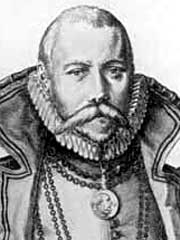12
Medieval Astronomy
Posted by jns on September 12, 2006

|

|
Isaac and I have both recently finished reading Tycho & Kepler, by Kitty Ferguson, and we thoroughly enjoyed it. (There’s more about the book in our Science Besieged Book Note.) Thus it happens that this beard and rather extravagent mustache belongs to the Danish astronomer Tycho Brahe.
Tycho, active in the second half of the 16th century, is often described as the greatest naked-eye astronomer in history. The biggest reason for this is that the telescope was just being invented — it was only in 1610 that Galileo discovered the moons of Jupiter in one of the earliest astronomical uses of the telescope. Think for a moment of what it must have been like to try to do science when, as Ms. Ferguson pointed out, geometry was the most advanced mathematics known. Calculus would not be invented by Newton & Leibnitz for nearly another century.
Regardless, he created some magnificent and clever instruments with which he made observations of unprecedented precision. In particular, he measured the orbits of the planets with enough accuracy that, just after Tycho’s death, Kepler finally hit on his (Kepler’s) 3 Laws of Planetary Motion and announced that the planets followed eliptical orbits. (The eccentricity of the orbits, which is to say the amount by which they are elliptical rather than circular, was very small and barely discernable.)
These portraits of Tycho do not represent his reddish-blond beard and quite remarkable mustache too clearly, but Ms. Ferguson’s description makes it clear that he was physically rather to my taste:
Tycho had just turned twenty-nine [in 1575] and was an experienced courtier, polished by his travels and attendance at many courts. Garbed appropirately with flowing cape, feathered hat, and sword, he was an imposing figure, barrel-chested, elegant, and of distinctly noble bearing. His eyes were light-colored, and his hair, beard, and substantial mustache were reddish blond. In portraits, his false nose looks a fairly successful imitation, close to flesh-colored — though an astute portrait painter would have made it so in any case. [p. 72]
[from: Kitty Ferguson, Tycho & Kepler : The Unlikely Partnership That Forever Changed Our Understanding of the Heavens. New York : Walker & Company, 2002.]
Oh, about the nose: in his youth Tycho got a substantial portion of his nose cut off during a rather pointless duel. Although it is true that he had an ersatz nose fashioned of gold alloy, it was for special occasions only. For everyday use he had a copper and tin alloyed nose. He had made both noses himself.